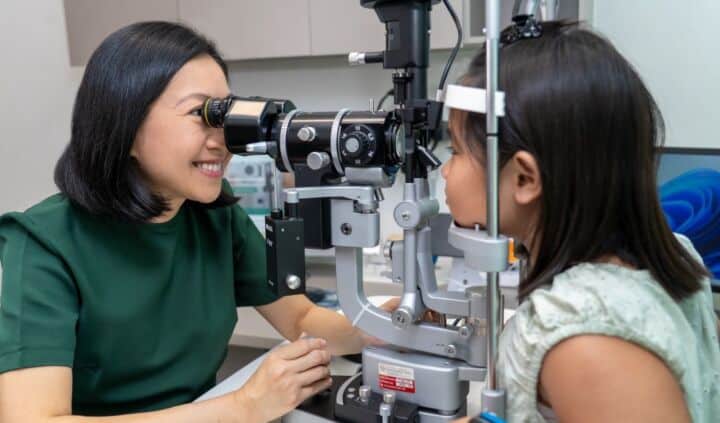Childhood Myopia: What Parents Need to Know

The world is witnessing a rapid rise in childhood myopia, or short-sightedness, transforming what was once a minor inconvenience into a significant public health concern. This widespread eye condition is affecting an increasing number of young individuals, often at alarmingly early ages.
In many regions in Asia, more than half of children are developing myopia by early adolescence, with a worrying trend of earlier onset. Projections for some populations suggest that by 20501, a vast majority of adults will be myopic, with a substantial proportion suffering from high myopia. This earlier development of myopia translates into more years for the condition to progress, often leading to higher degrees of short-sightedness in adulthood.
Why is myopia in children so prevalent?
The high prevalence of myopia in children is a complex interplay of environmental, lifestyle, and genetic factors:
Limited outdoor time
Urbanisation and modern conveniences often limit children’s opportunities for outdoor play. Spending time outdoors, particularly in natural light, is crucial. It is believed to stimulate the release of dopamine in the retina, which helps prevent excessive eyeball elongation – the underlying cause of myopia. Research suggests that even a modest amount of daily outdoor time can significantly reduce risk.
Intensive near work
Modern lifestyles, often driven by academic pressures or sedentary hobbies, frequently translate into long hours of reading, studying, and other “near work” activities from a young age. This prolonged focus on close objects has been associated with the development of myopia.
Increased screen time
The ubiquitous presence of digital devices has led to a dramatic increase in screen time for children. Staring at screens for extended periods, especially at close distances, further contributes to “near work” activities and reduces time spent outdoors.
Genetics
While environmental factors play a huge role, genetics also plays a part. Children with myopic parents are significantly more likely to develop the condition, with the risk increasing if both parents are short-sighted.

The long-term risks of high myopia
Myopia is more than just needing glasses. High myopia, often defined as -6.00 dioptres or more, significantly increases the risk of serious, potentially sight-threatening eye complications later in life, including:
- Early-onset cataracts
Clouding of the eye’s natural lens.
- Glaucoma
Damage to the optic nerve, often due to increased eye pressure.
- Retinal detachment and tears
Separation of the light-sensitive tissue at the back of the eye.
- Myopic maculopathy
Degeneration of the central part of the retina, leading to blurred central vision.
Prevention and management
Given the irreversible nature of myopia, the focus is now placed heavily on prevention and slowing its progression. Key strategies include:
More outdoor time
Health authorities worldwide encourage children to spend sufficient time outdoors daily. This simple habit is one of the most effective preventive measures.
Reduce intensive near work
Encourage frequent breaks (e.g. the 20-20-20 rule: every 20 minutes, look at something 20 feet away for 20 seconds), maintaining proper reading distances, and ensuring good lighting are crucial.
Screen time management
While digital devices are an integral part of modern life, limiting recreational screen time and establishing screen-free periods are vital.
Regular eye checks
Early detection is key. Regular comprehensive eye examinations allow for timely intervention and monitoring of myopia progression.
Myopia control treatments
For children who are already myopic, various treatments are available to slow down the progression, including:
- Atropine eye drops
Low-concentration atropine drops have shown significant effectiveness in slowing myopia progression. - Specialised spectacles and contact lenses
Options like peripheral defocus spectacles and myopia control contact lenses have been shown to reduce the elongation of the eyeball and slow myopia progression.

Addressing childhood myopia requires a concerted effort from parents, educators, and healthcare professionals. By understanding the causes and embracing preventive and management strategies, we can play a pivotal role in safeguarding the vision of the next generation.
1 Moh.gov.sg. (2019). Speech By Dr Lam Pin Min, Senior Minister Of State For Health, At The Opening Of The Singapore National Eye Centre’s Myopia Centre, 16 August 2019 | Ministry of Health. [online] Available at: https://www.moh.gov.sg/newsroom/speech-by-dr-lam-pin-min-senior-minister-of-state-for-health-at-the-opening-of-the-singapore-national-eye-centre-s-myopia-centre-16-august-2019 [Accessed 10 Jul. 2025].



